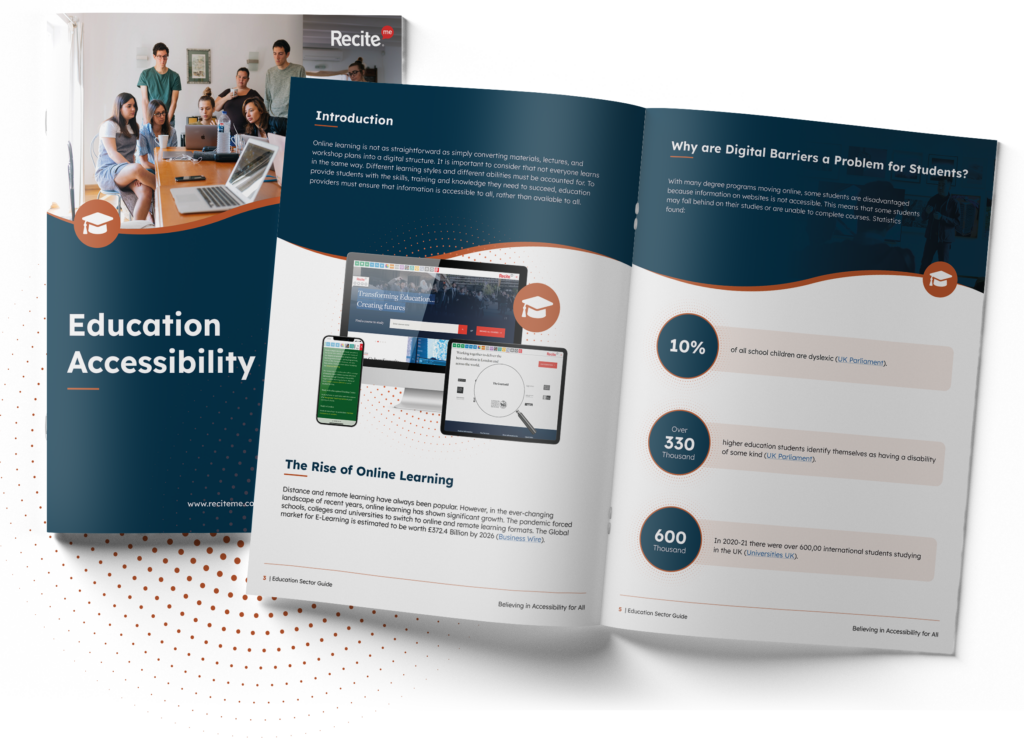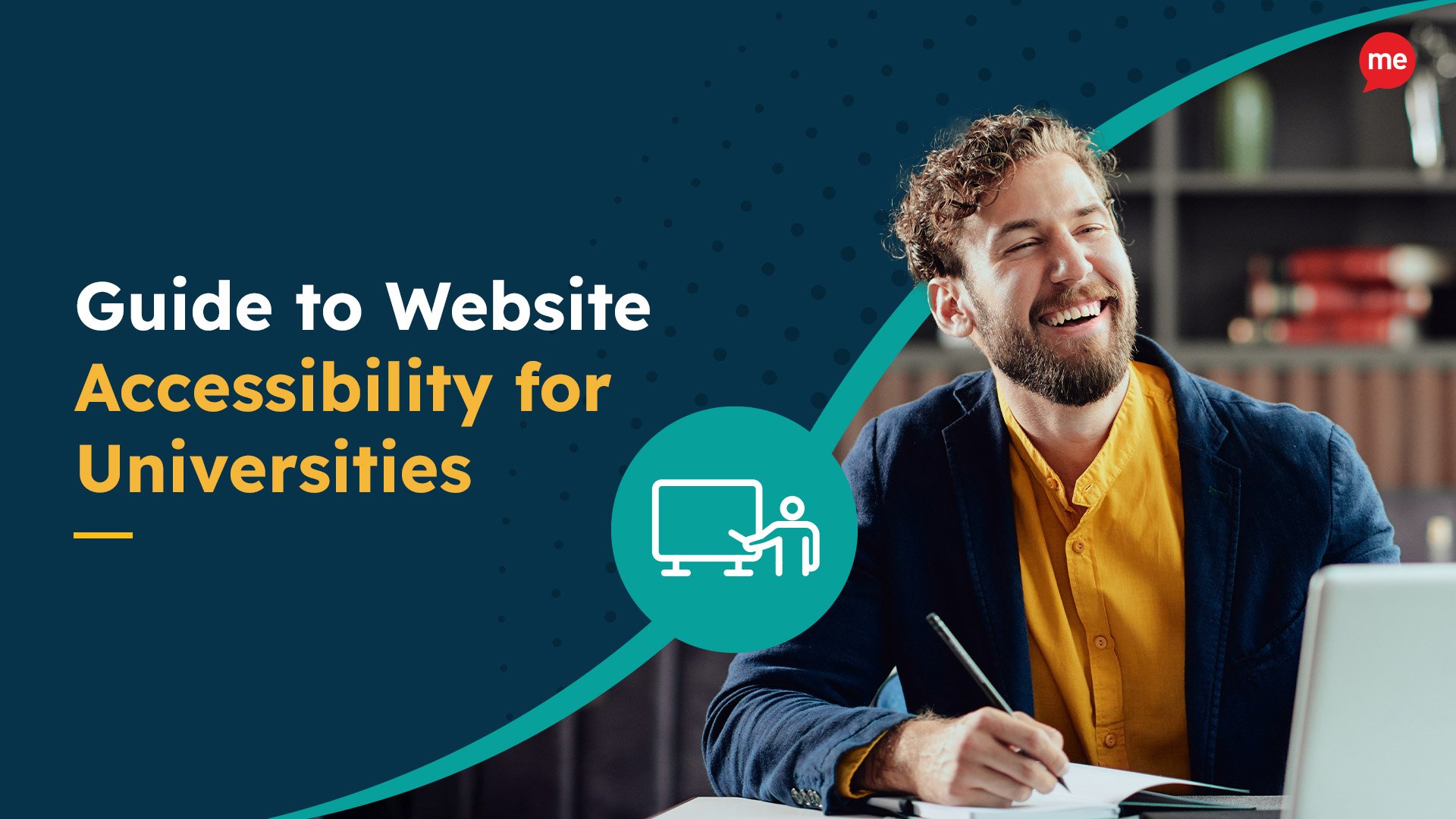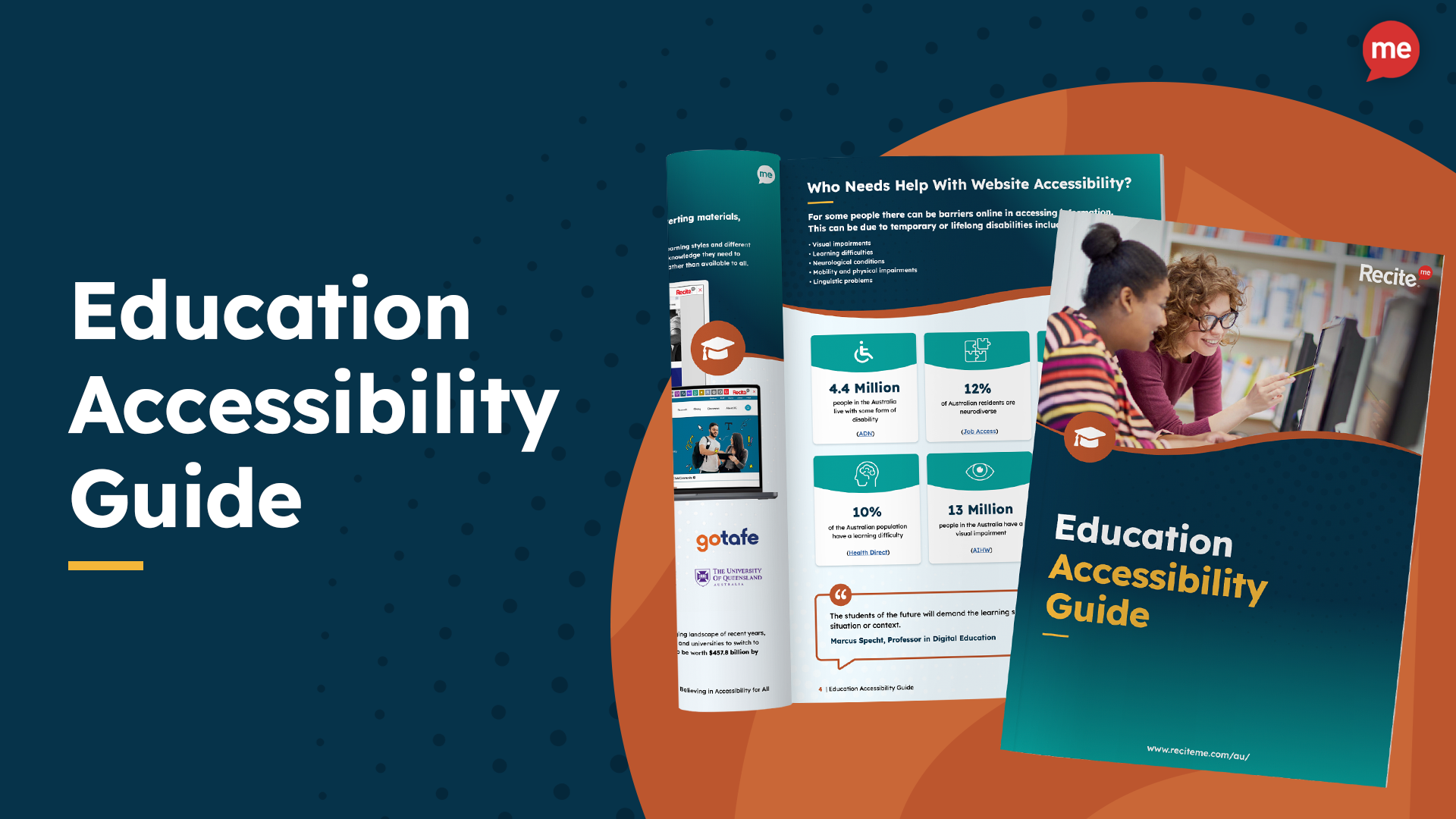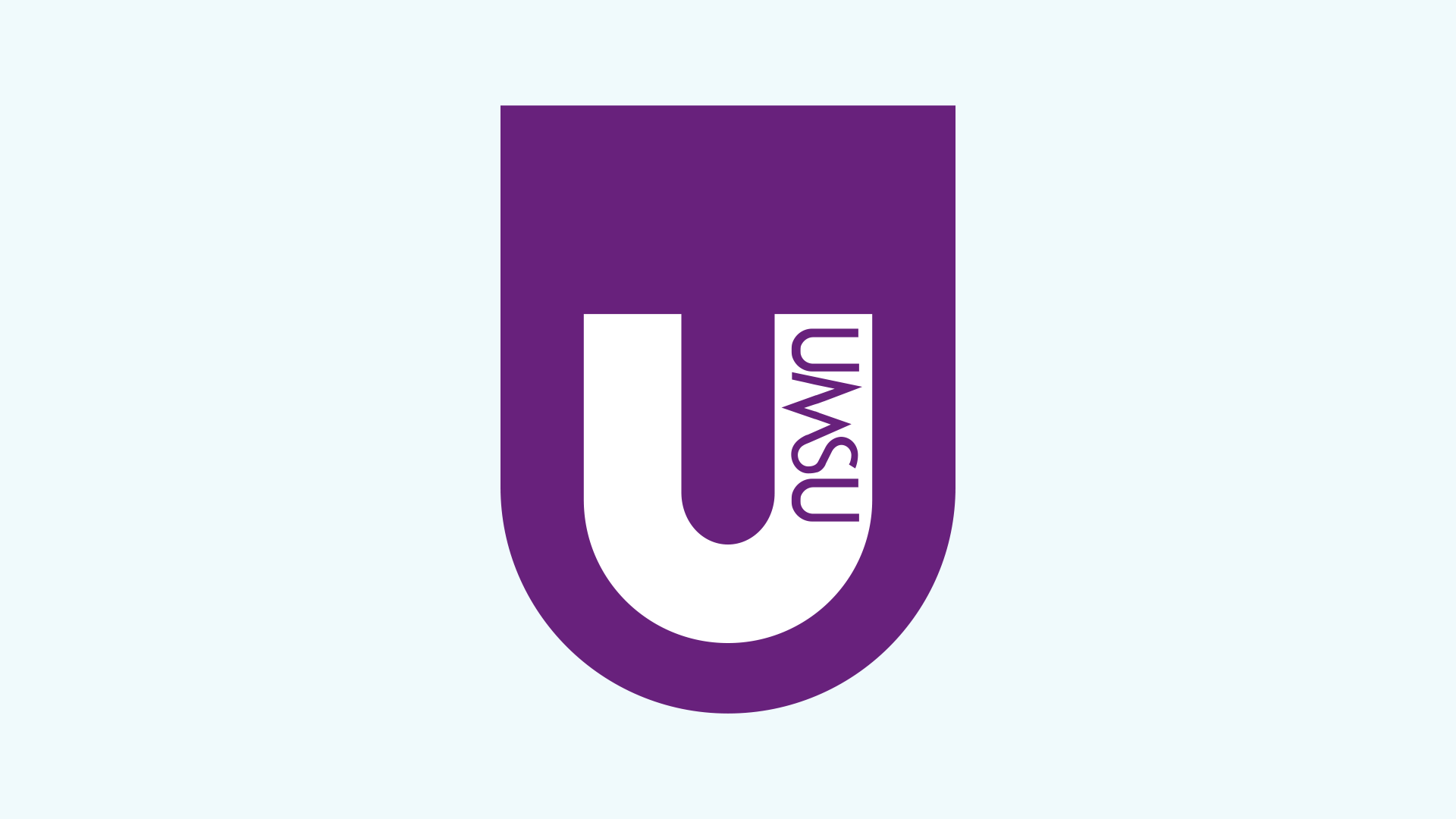Get Your Free Education Accessibility Guide
Download NowHigher Education is a type of tertiary education that comes after the completion of secondary education. Unlike secondary education, higher education is completely optional. It usually involves attendance of a University or College, where students take specialised subjects and/or courses to work towards a qualification or academic degree.
The topic of accessibility in education is an important one at all levels of education, higher education is not excluded from that. A recent study found that 7.44% of Australian undergraduates reported having at least one disability. The report also found that around 35% of people over 20, without a disability have a bachelor’s degree, this number drops to 17% if the person has a disability. This highlights the need for improving the quality and experience of higher education for students with disabilities. Accessibility has been shown to be an important consideration in this.
What is Accessible Technology?
Accessible technology refers to any device, software, application, or system designed or adapted in a way that ensures people with disabilities can access, use, and benefit from its functionality on an equal basis with others. This technology aims to remove barriers to digital and electronic information, communication, and services, ensuring inclusivity and equal opportunities for all users, regardless of their physical or cognitive abilities.
Conceptualising this into the world of higher education would require educators to ensure their website, digital resources, tools and learning processes are all accessible. So, educators will need to ensure that each and every student can access and use online content just as effectively as non-disabled students.
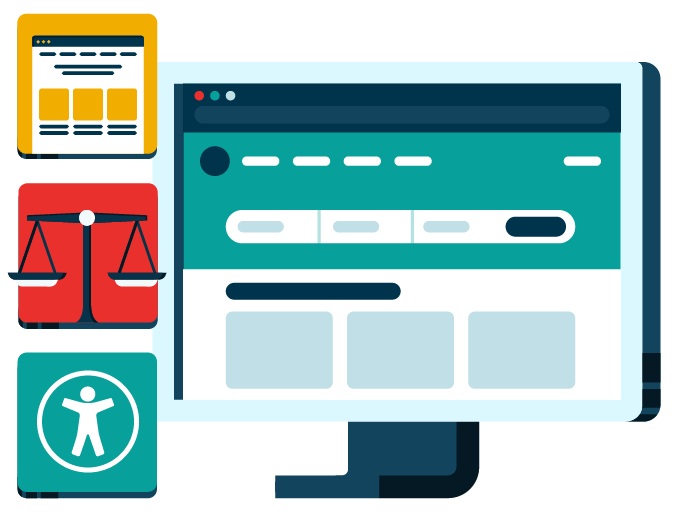
Challenges that Disabled People face in Higher Education
The challenges that disabled people face on a daily basis can significantly impact them, both inside of education and outside. It can have adverse effects on their interpersonal skills, affecting factors such as their confidence, self-esteem, happiness levels and more. Some of the main causes of this in current higher education are as follows:
Physical Barriers
Inaccessible facilities with outdated infrastructure and design is the most obvious challenge to people with disabilities. There are an almost endless number of examples, however, some of the most frequent include:
- Inaccessible Transportation: Lack of accessible transportation options to and from campus can pose challenges for students with disabilities, affecting their ability to attend classes, participate in events, or access off-campus resources.
- Classroom Accessibility: Some classrooms may not be designed with accessibility in mind. This could mean that there are no designated seating areas for students who use wheelchairs, or that the classroom lacks assistive listening systems for students with hearing impairments.
- Inaccessible Facilities: Facilities such as libraries, laboratories, and recreational areas might not be designed to accommodate individuals with disabilities. For example, high bookshelves in libraries can be inaccessible to students using wheelchairs, or lab equipment might not be adapted for students with certain physical disabilities.
- Inadequate Restrooms: Restrooms that are not equipped with appropriate accommodations, such as grab bars, wide stalls, or accessible sinks, can pose significant challenges for students with mobility impairments or other disabilities.
Online Barriers
The importance of the digital world being accessible is just as important as the real world now. Particularly as learning continues to move further towards the use of digital technologies and resources. Some of the most significant online barriers that challenge disabled students include the following:
- Limited Access to Course Materials: If online course materials, such as PDFs, videos, Images, Websites or other online resources, are not available in accessible formats, students with disabilities may struggle to obtain or understand essential information.
- Barriers to Communication: Platforms and tools that are not compatible with assistive technologies can create barriers for students with disabilities. Making it difficult for them to participate in discussions, collaborate with peers, or communicate with instructors.
- Exclusion from Online Assessments: Inaccessible online assessment tools may prevent disabled students from demonstrating their knowledge and skills effectively, potentially leading to unfair evaluations and academic challenges.
- Lack of Accommodations: Without proper accommodations, such as captioning for videos, alternative text for images, or adjustable font sizes, students with disabilities may face difficulties in accessing and engaging with digital content.
Download our Accessibility Education Guide
Download our inclusive education guide which looks at why digital barriers are a problem, who needs support, the importance of inclusive education, Recite Me clients, and an overview of our data from the past year.What can be done to Create Accessible Learning Environments?
With such a wide variety of disabilities existing in the world today, there are a huge number of accommodations and improvements higher education institutions can provide to their students. In doing so, they will help to enhance the accessibility of the institution and provide a better experience for their students. Some examples of actions that higher education providers can implement include the following.
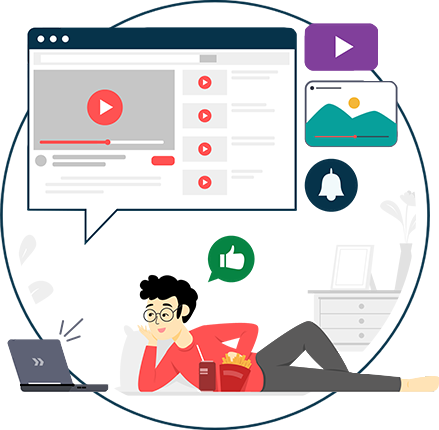
Accessible Multi-media Alternatives
Educators should provide accessible alternatives for any multi-media that is featured in learning materials. Examples of this would include image alternative text to describe images, this allows users with visual impairments to gain access to information and context stored in images.
Another example could be providing written transcripts to video content, this again allows assistive technology for users with low vision or blindness to feed the information back to the user about the information being provided. For Video content, it is also important to include subtitles for those who experience hearing impairments.
Easy to Navigate Online Platforms
Navigation of digital environments and platforms is crucial, especially for individuals who experience mobility issues and/or motor disabilities. As these disabilities can often have a significant effect on the users ability to easily navigate to find information they are looking for.
An example of good navigation is where websites have created strong keyboard accessibility. This idea revolves around the fact that many users have significant difficulty using mouses to navigate digital resources. Instead they should be able to navigate by using only a keyboard. This allows them to navigate faster, more accurately and easier, allowing their time and energy to be focused on digesting the learning materials as opposed to just trying to access them.
Other examples highlight the importance of mobile accessibility in navigation. Small touch targets, inconsistent layouts, difficult data entry methods and non-responsive design structures are just a few of the many challenges that make using mobile devices difficult for people with mobility issues. While it’s unlikely that a student will be doing a large volume of work from their mobile, it still presents a challenge. Situations such as students looking back to old learning materials during a lecture or trying to do some additional research or learning while they travel on public transport are a few obvious examples. If educators are able to address the above issues and create strong accessibility for their mobile users this will create a better environment for everyone.
Ensure Compatibility with Assistive Technologies
The importance of assistive tools such as Screen Readers, Alternative Input Devices, Magnification Software and more can not be underestimated. They play a vital role in leveling the playing field for individuals who experience challenges due to their disabilities. As such, it is important that educators can provide resources that are compatible with these tools. For example, PDF documents should still allow users to customize in terms of magnification, font sizes and font types, while also ensuring the PDF document can be read via screen reader technology.
You can learn more about Assistive Technology in Education here.
Customisable Experiences
Everyone has their own individual preferences, this is something that is easy to understand and see. The ability to customise a website’s design in a way that works best for the user can be useful. For example, people with low vision could find the ability to zoom in and out of specific areas of digital content useful. Furthermore, individuals with dyslexia typically have a preference for dyslexia-friendly fonts, so the ability to customise font type can be beneficial.
Again, this isn’t just something that is beneficial to disabled people exclusively. It makes sense that the ability to customise a website’s features to your individual preference would enhance user experience and satisfaction.
Accessible Physical Facilities
The last suggestion is of course the most obvious, having accessible facilities at the institution’s physical location. While this is not something we can help with at Recite Me, it is still important to note its importance. Educational institutes should look to provide easy access to classrooms, toilets and all other facilities, through the use of ramps, lifts, disabled seating areas, grab bars, accessible sinks and more.
Luckily the physical world is not as far behind as the digital world. Many institutes already recognise the importance of having physical facilities that are accessible to everyone. We are beginning to see the shift towards digital accessibility in higher education too and believe that everyone has the right to access education both digitally and physically.
Our 40-page Digital Accessibility & Inclusion Toolkit helps businesses break down online barriers and make a real impact. It offers practical advice on all aspects of digital accessibility, from writing an accessibility statement to accessible website tips and inclusive hiring.
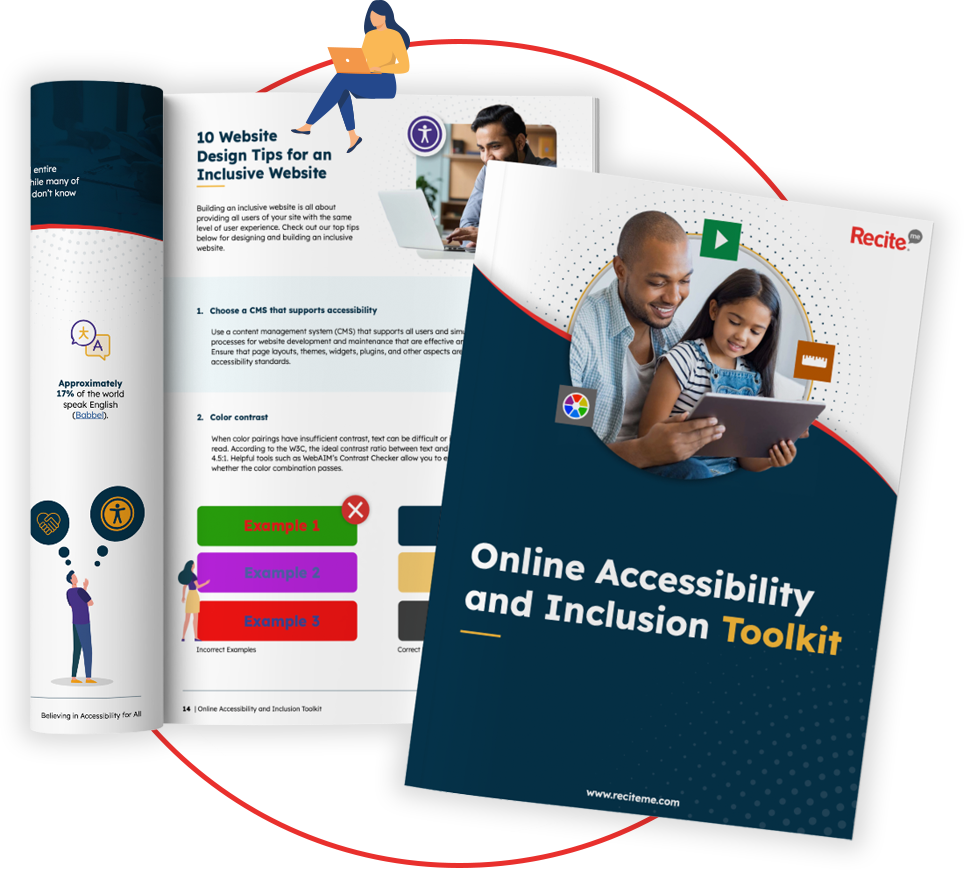
How can Recite Me Help?
Recite Me is one of the leading providers of accessibility solutions, we are committed to making the digital world a more accessible and inclusive environment. We are already partnered and working with numerous different educational institutions and long may this continue. Some of our products and services include the following.
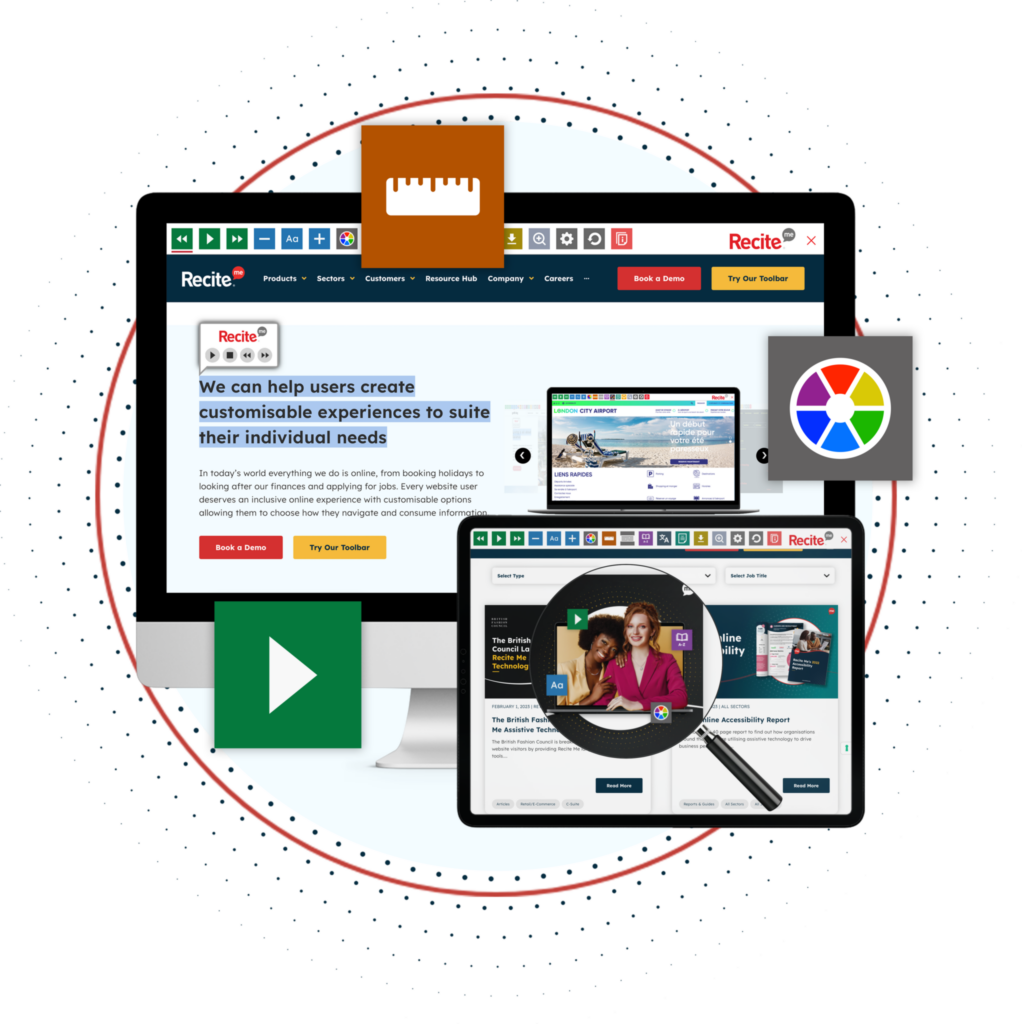
Accessibility Toolbar
Our Accessibility Toolbar is our longest standing product, it works by integrating with the universities, college or other institutions website. Once integrated, the toolbar can be used for a variety of different functions, mainly allowing the user to customise the website to suit their needs and preferences. Some of the Toolbars main features include:
- Personalise font size, colour and type.
- Screen Mask & Ruler tools for reading.
- Download written content as an audio file.
- Text-to-speech.
- Translation to over 100 languages.
- Customising PDF documents.
Accessibility Checker
Our Recite Me Accessibility Checker is a tool that higher education providers can use to highlight and fix inaccessible website design. The tool works by taking the URL of your website and performing a scan of the domain. The checker will then pull a report of accessibility issues into an actionable list, with suggestions and recommendations to help you resolve the issues. The step by step process of the checker is as follows:
- Step 1: Scan Your Domains
- Step 2: Identify Accessibility Issues
- Step 3: Fix Accessibility Errors
- Step 4: Track Your Progress
- Step 5: Download & Share and Accessibility Report
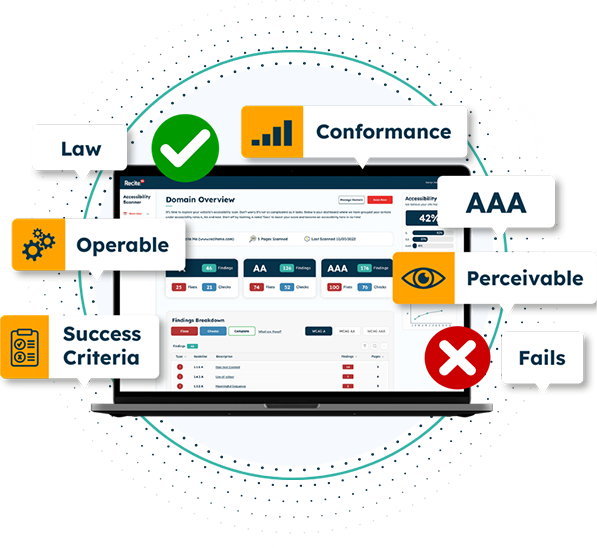
If you’re interested to learn more about our products or book a demo of them, you can speak to an expert at Recite Me today.

